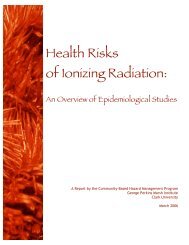Elsevier Editorial System(tm) for Mycological ... - Clark University
Elsevier Editorial System(tm) for Mycological ... - Clark University
Elsevier Editorial System(tm) for Mycological ... - Clark University
You also want an ePaper? Increase the reach of your titles
YUMPU automatically turns print PDFs into web optimized ePapers that Google loves.
summarized in Tables 1-3, which list selected phylogenetic studies, the type of data that<br />
were analyzed, the number of OTUs sampled, and bootstrap frequencies and Bayesian<br />
posterior probabilities. No attempt has been made to cite all of the relevant studies <strong>for</strong><br />
each group. The analyses chosen <strong>for</strong> inclusion in the Tables are those that have the<br />
greatest numbers of loci or taxa, and that provide the strongest support <strong>for</strong> monophyly<br />
of the clades in question. To supplement the in<strong>for</strong>mation in the tables, brief comments<br />
on synonyms, phylogenetic relationships, and composition are provided below <strong>for</strong><br />
some taxa, along with bibliographic citations <strong>for</strong> all taxon names. However, it is beyond<br />
the scope of this article to discuss each taxon in detail. For additional literature on the<br />
phylogeny and taxonomy of individual taxa, readers should consult the studies listed in<br />
Tables 1-3 and below, and the references therein.<br />
The classification is also presented as a set of tree diagrams (Figs 1-3). Taxa of<br />
uncertain position are listed as incertae sedis, and have been placed at the least inclusive<br />
level in the hierarchy where they can be assigned with confidence. There are several<br />
nodes resolved in the tree figure that are not reflected in the classification (Figs 1-3).<br />
These unnamed clades, <strong>for</strong> which there is strong to moderate support in recent studies,<br />
include the Dacrymycetes plus Agaricomycetes (Basidiomycota) (Matheny et al. 2006,<br />
2007a), Saccharomycotina plus Pezizomycotina (Ascomycota) (James et al. 2006; Spata<strong>for</strong>a et<br />
al. 2007), and the inoperculate euascomycetes (Ascomycota) (e.g. Lumbsch et al. 2002).<br />
The inoperculate euascomycetes has been recognized as a superclass, the Leotiomyceta<br />
(Eriksson & Winka 1997; Lumbsch et al. 2002), which is a rank that is not employed<br />
here, while the Dacrymycetes plus Agaricomycetes correspond to the subclass<br />
Hymenomycetidae of Swann & Taylor (1995). The absence of these groups from the<br />
present classification should not be interpreted as a judgment on their monophyly.<br />
Rather, it reflects a desire to keep the classification simple, and to minimize the number<br />
11
















